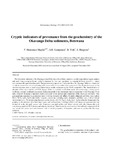Please use this identifier to cite or link to this item:
http://hdl.handle.net/10311/153Full metadata record
| DC Field | Value | Language |
|---|---|---|
| dc.contributor.author | Huntsman-Mapila, P. | |
| dc.contributor.author | Kampunzu, A.B. | |
| dc.contributor.author | Vink, B. | |
| dc.contributor.author | Ringrose, S. | |
| dc.date.accessioned | 2008-07-03T10:45:40Z | |
| dc.date.available | 2008-07-03T10:45:40Z | |
| dc.date.issued | 2005 | |
| dc.identifier.citation | Huntsman-Mapila, P. et al (2005) Cryptic indicators of provenance from the geochemistry of the Okavango Delta sediments, Botswana, Sedimentary Geology 174. pp. 123-148 | en |
| dc.identifier.issn | 0037-0738 | |
| dc.identifier.uri | http://hdl.handle.net/10311/153 | |
| dc.description | This paper was a contribution to the SAFARI 2000 Research Project. | en |
| dc.description.abstract | [Please note that chemical formulae do not display properly]:The siliciclastic sediments of the Okavango inland Delta of northwest Botswana have a modal composition of quartz arenites and result from a complex history, including transport by river and deposition in a nascent rift basin located in a desert environment with input of aeolian sands. The geochemical composition of sediments from the Okavango Delta was determined in order to constrain the role of weathering at the source and the composition of the source rocks. The chemical analyses and the interelement ratios show a broad compositional range usually encompassing the PAAS composition. The chemical index of alteration (CIA) values and the A-CN-K diagram define an evolution trend which can be interpreted using a mixing model involving a strongly weathered component which corresponds to the sedimentary fraction transported by the Okavango River and a relatively immature component which corresponds to the aeolian sand component of the Okavango sediments. Field geological data supported by geochemical ratios involving elements with affinity for mafic-ultramafic and felsic rocks such as Th/Cr, Th/Sc, La/Sc, La/Co and Eu/Eu* support a source area including mafic-ultramafic and felsic rocks, with or without intermediate rocks. The relationships between certain elements (Cr-Ni, Na2O-Al2O3, K2O- Al2O3) refine the interpretation by pointing to the existence of at least three source rock end-members, including a felsic rock source and pyroxene-rich and olivine-rich mafic-ultramafic source rocks. Proterozoic granitoid-gabbro and related volcanic and ortho-metamorphic rock complexes exposed in NW Botswana and adjacent Angola and Namibia are the source rocks of the sediment component which was mixed with aeolian sand and interacted with a variable proportion of diagenetic carbonates to produce the Okavango sediments. | en |
| dc.language.iso | en | en |
| dc.publisher | Elsevier; http://www.elsevier.com/wps/find/journaldescription.cws_home/503361/description#description | en |
| dc.subject | Geochemistry | en |
| dc.subject | Provenance | en |
| dc.subject | Okavango Delta | en |
| dc.subject | Botswana | en |
| dc.title | Cryptic indicators of provenance from the geochemistry of the Okavango Delta sediments, Botswana | en |
| dc.type | Article | en |
| Appears in Collections: | Research articles (ORI) | |
Files in This Item:
| File | Description | Size | Format | |
|---|---|---|---|---|
| huntsman_mapila_sedgeo.pdf | 5.95 MB | Adobe PDF |  View/Open | |
| license.txt | 1.95 kB | Text | View/Open |
Items in DSpace are protected by copyright, with all rights reserved, unless otherwise indicated.
